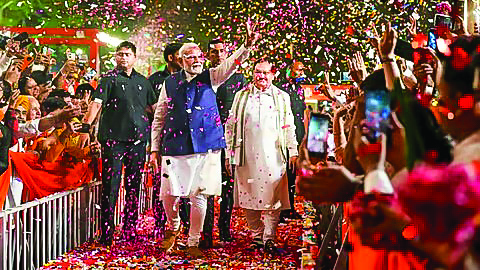Looking ahead, strategic autonomy will continue to underpin India’s foreign policy priorities.
The first 100 days of Modi 3.0 mark a critical phase for India’s foreign policy landscape. Traditionally, this period is seen as a window for decisive action
With the NDA government’s return to power, albeit with a reduced majority, the focus on foreign policy gains prominence in navigating global challenges amid shifting geopolitical dynamics.
For his first term in 2014, Prime Minister Narendra Modi had tried to revive the South Asian Association of Regional Cooperation (SAARC) by inviting India’s immediate neighbours for the swearing-in ceremony. In 2019, leaders from the BIMSTEC nations were invited—Bangladesh, Myanmar, Sri Lanka, Thailand, Nepal, and Bhutan. It signalled a move away from Pakistan and embraced the “Act East” policy while focusing on economic diplomacy and connectivity.
Arguably, the Modi administration has given a lot of thought to external relations. Foreign policy debates earlier were seen as an elite phenomenon, removed from the domestic policy arena. However, the last ten years have seen a democratization of the foreign policy discussions. Regular “master classes” by foreign minister S. Jaishankar have broadened the discussion base of how India is conducting its foreign affairs. India’s presidency of G20, or its “strategic autonomy” stand, avoiding alliances in the Ukraine-Russia conflict or Israel-Palestine conflict has been a subject of chatter among the “aam aadmi”. India’s engagement has deepened with regions it views as vital—the Indo-Pacific, the Middle East, and the West. India has been largely successful in creating a brand of itself in terms of civilizational attributes, strong diaspora ties, and robust democratic credentials. The government has been using terms like “Viksit Bharat”, “Vishwaguru” and “Vishwamitra” which sit well with the common citizenry and amplified India’s claim as a civilizational power.
Looking ahead, strategic autonomy will continue to underpin India’s foreign policy priorities. It is interesting to see how its relationship with the United States pans out in case Donald Trump regains power in the upcoming US elections. While the India-US relationship is likely to become more transactional with a new President in White House, New Delhi’s multi-alignment calculation will be put to test if the Russia-Ukraine war aggravates.
Simultaneously, trade and economic engagements, especially with the UK, EU, and Gulf nations, will shape India’s integration into global supply chains and bolster its manufacturing sector. India has already been on its way to signing trade agreements with several countries—the United Kingdom, European Union, and Gulf nations to boost local manufacturing and job creation. Trade talks with the UK and Oman are in the final stages, while negotiations are ongoing with the EU. India has already signed a trade deal with Australia, the UAE, and a grouping of four European countries—Switzerland, Iceland, Norway and Liechtenstein.
The Viksit Bharat agenda is going to see greater emphasis on manufacturing. The Indian government has already approved a policy to promote India as a manufacturing destination so that e-vehicles (EVs) with the latest technology can be manufactured in the country. The policy is designed to attract investments in the e-vehicle space by reputed global EV manufacturers. The next few months should see more activity in this regard. India is already providing production-linked incentives such as tax cuts, rebates, and capital support for MNCs to ramp up co-production. The government has offered a total of $28 billion of subsidies for firms in 14 sectors as a way of encouraging increases in output. The semiconductor industry has also been on the receiving end of government largesse, for which an additional $10 billion has been made available.
The government aims to provide jobs, end poverty, create wealth, and enhance India’s global influence. The government would therefore focus on trade and investment agreements that would integrate its manufacturing sector more robustly with other countries, and allow India to play a full role in global supply chains. However, till now India’s share of global manufacturing remains anaemic at below 3%. To boost the sector, India needs to take up land, labour and capital reforms which will not be an easy task considering that NDA is below 300 seats and BJP is standing at 240 seats.
Some of the challenges that lay stark in front of the government are technological disruptions such as artificial intelligence and semiconductor developments. These will involve not only carving a domestic policy but also keeping those in sync with the policies of other like-minded nations. Tech is a force multiplier in international relations and is as much strategic as commercial.
Apart from that Modi 3.0 will also work on carving a peaceful periphery for itself, which would involve dealing with the China challenge and revitalising ties with the neighbours and the Indo-Pacific members. In the coming months, India will present itself more squarely as the “voice of the Global South”. The foreign ministry is planning to open 19 more missions and posts abroad, increase India’s passport coverage to 10% of the population and open “videsh bhawans” in select state capitals. This is to expand the diplomatic footprint. There are plans to open six new missions and two consulates in the first 100 days of the new government. This will also help in safe international migration and the mobility of skilled workers from India.
As Modi 3.0 embarks on its journey, the first 100 days serve as a crucial litmus test, setting the tone for India’s proactive engagement on the world stage and reaffirming its aspirations as a global leader in the 21st century.
Dr Shreya Upadhyay is Deputy Director, Kalinga Institute of the Indo-Pacific Studies.

